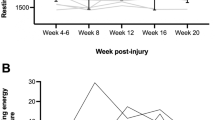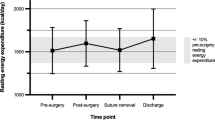Abstract
Background:
Accurate estimation of energy needs is vital for effective nutritional management of individuals with spinal cord injury (SCI). Inappropriate energy prescription after SCI can compound the rates of malnutrition or obesity, increase the risk of complications and negatively influence outcomes. Energy requirements following SCI are not well understood, and there is currently no universally accepted method of estimating energy needs in clinical practice.
Study design:
This is a systematic literature review.
Objectives:
The objectives of this study were to investigate and compare the measured resting energy needs of adults with SCI across different phases of rehabilitation, and to identify appropriate energy prediction equations for use in SCI.
Setting:
This study was conducted in Australia.
Methods:
MEDLINE, EMBASE and CENTRAL databases were searched for studies published between 1975 and April 2015, identifying 298 articles. Full articles in English language of adults with SCI who were fasted for a minimum of 8 hours before undergoing indirect calorimetry to measure resting energy expenditure (REE) for at least 20 min were selected. On the basis of the inclusion criteria, 18 articles remained for data extraction. One author extracted information from all articles, and inter-rater reliability was tested in five articles.
Results:
REE across three phases of injury was assessed: acute, sub-acute and chronic. Few studies (n=2) have investigated REE in the acute and sub-acute injury stages of SCI recovery. The factors influencing chronic energy needs in SCI patient populations are many and varied, and a valid predictive equation for use in SCI remains elusive.
Conclusion:
Indirect calorimetry remains the only accurate assessment of REE for health practitioners working with patients after SCI.
Similar content being viewed by others
Log in or create a free account to read this content
Gain free access to this article, as well as selected content from this journal and more on nature.com
or
References
Dionyssiotis Y . Malnutrition in spinal cord injury: more than nutritional deficiency. J Clin Med Res 2012; 4: 227–236.
Gorgey AS, Chiodo AE, Zemper ED, Hornyak JE, Rodriguez GM, Gater DR . Relationship of spasticity to soft tissue body composition and the metabolic profile in persons with chronic motor complete spinal cord injury. J Spinal Cord Med 2010; 33: 6–15.
Yilmaz B, Yasar E, Goktepe AS, Onder ME, Alaca R, Yazicioglu K et al. The relationship between basal metabolic rate and femur bone mineral density in men with traumatic spinal cord injury. Arch Phys Med Rehab 2007; 88: 758–761.
Monroe MB, Tataranni PA, Pratley R, Manore MM, Skinner JS, Ravussin E . Lower daily energy expenditure as measured by a respiratory chamber in subjects with spinal cord injury compared with control subjects. Am J Clin Nutr 1998; 68: 1223.
Tanhoffer RA, Tanhoffer AIP, Raymond J, Hills AP, Davis GM . Comparison of methods to assess energy expenditure and physical activity in people with spinal cord injury. J Spinal Cord Med 2012; 35: 35–45.
Garrow JS, James WPT . Human Nutrition and Dietetics. 9th edn Churchill Livingstone Medical Division, New York, NY, USA. 1993.
Buchholz AC, McGillivray CF, Pencharz PB . Differences in resting metabolic rate between paraplegic and able-bodied subjects are explained by differences in body composition. Am J Clin Nutr 2003; 77: 371.
Cox SA, Weiss SM, Posuniak EA, Worthington P, Prioleau M, Heffley G . Energy expenditure after spinal cord injury: an evaluation of stable rehabilitating patients. J Traum 1985; 25: 419–423.
Spungen AM, Bauman WA, Wang J, Pierson JRN . The relationship between total body potassium and resting energy expenditure in individuals with paraplegia. Arch Phys Med Rehab 1993; 74: 965.
American Dietetic Association Spinal Cord Injury (SCI) Evidenced-Based Nutrition Practice Guideline. American Dietetic Association: Chicago (IL). 2009.
Yilmaz B, Yasar E, Goktepe S, Alaca R, Yazicioglu K, Dal U et al. Basal metabolic rate and autonomic nervous system dysfunction in men with spinal cord injury. Obesity 2007; 15: 2683–2687.
Buchholz AC, McGillivray CF, Pencharz PB . Physical activity levels are low in free-living adults with chronic paraplegia. Obes Res 2003; 11: 563–570.
Lee M, Zhu W, Hedrick B, Fernhall B . Estimating MET values using the ratio of HR for persons with paraplegia. Med Sci Sports Exerc 2010; 42: 985–990.
Bauman WA, La Fountaine MF, Cirnigliaro CM, Kirshblum SC, Spungen AM . Lean tissue mass and energy expenditure are retained in hypogonadal men with spinal cord injury after discontinuation of testosterone replacement therapy. J Spinal Cord Med 2015; 38: 38–47.
National H, Medical Research C How to Use the Evidence: Assessment and Application of Scientific Evidence. NHMRC: Canberra. 2000.
Weir JB . New methods for calculating metabolic rate with special reference to protein metabolism. J Physiol 1949; 109: 1–9.
Roffey DM, Byrne NM, Hills AP . Day-to-day variance in measurement of resting metabolic rate using ventilated-hood and mouthpiece & nose-clip indirect calorimetry systems. JPEN J Parenter Enteral Nutr 2006; 30: 426–432.
Academy of Nutrition and Dietetics Evidence Analysis Library Spinal Cord Injury Toolkit. Academy of Nutrition and Dietetics: Chicago (IL). 2014.
Fehlings MG, Rabin D, Sears W, Cadotte DW, Aarabi B . Current practice in the timing of surgical intervention in spinal cord injury. Spine 2010; 35: S166–S173.
Grossman RG, Frankowski RF, Burau KD, Toups EG, Crommett JW, Johnson MM et al. Incidence and severity of acute complications after spinal cord injury. J Neurosurg-Spine 2012; 17: 119–128.
Rodriguez DJ, Clevenger FW, Osler TM, Demarest GB, Fry DE . Obligatory negative nitrogen balance following spinal cord injury. JPEN J Parenter Enteral Nutr 1991; 15: 319–322.
Wolfe DL, Hsieh JTC, Mehta S . Rehabilitaion practices and associated outcomes following spinal cord injury. In: Eng JJ, Teasell RW, Miller WC, Wolfe DL, Townson AF, Hseih JTC et al. (eds). Spinal Cord Injury Rehabiliation Evidence, Version 4.0 2012. http://www.scireproject.com/rehabilitation-evidence/rehabilitation-practices.
Kirshblum SC, Burns SP, Biering-Sorensen F, Donovan W, Graves DE, Jha A et al. International standards for neurological classification of spinal cord injury (Revised 2011). J Spinal Cord Med 2011; 34: 535–546.
Lee M, Zhu W, Hedrick B, Fernhall B . Determining metabolic equivalent values of physical activities for persons with paraplegia. Disabil Rehabil 2010; 32: 336–343.
Gorgey AS, Gater DR . Regional and relative adiposity patterns in relation to carbohydrate and lipid metabolism in men with spinal cord injury. Appl Physiol Nutr Me 2011; 36: 107–114.
Collins EG, Gater D, Kiratli J, Butler J, Hanson K, Langbein WE . Energy cost of physical activities in persons with spinal cord injury. Med Sci Sport Exer 2010; 42: 691–700.
Abel T, Platen P, Rojas Vega S, Schneider S, Strüder HK . Energy expenditure in ball games for wheelchair users. Spinal Cord 2008; 46: 785–790.
Food and Agriculture Organization (FAO) Food Energy - Methods of Analysis and Conversion Factors FAO Food and Nutrition Paper 77. Report of a Technical Workshop Rome, 3–6 December 2002. Rome. 2003.
Schneider DA, Sedlock DA, Gass E, Gass G . VO2peak and the gas-exchange anaerobic threshold during incremental arm cranking in able-bodied and paraplegic men. Eur J Appl Physiol Occup Physiol 1999; 80: 292–297.
Aquilani R, Boschi F, Contardi A, Pistarini C, Achilli MP, Fizzotti G et al. Energy expenditure and nutritional adequacy of rehabilitation paraplegics with asymptomatic bacteriuria and pressure sores. Spinal Cord 2001; 39: 437–441.
Bauman WA, Cirnigliaro CM, La Fountaine MF, Jensen AM, Wecht JM, Kirshblum SC et al. A small-scale clinical trial to determine the safety and efficacy of testosterone replacement therapy in hypogonadal men with spinal cord injury. Horm Metab Res 2011; 43: 574–579.
Hayes M, Chustek M, Wang Z, Gallagher D, Heshka S, Spungen A et al. DXA: potential for creating a metabolic map of organ-tissue resting energy expenditure components. Obes Res 2002; 10: 969–977.
Sedlock DA, Laventure SJ . Body composition and resting energy expenditure in long term spinal cord injury. Paraplegia 1990; 28: 448.
Rutten P, Blackburn GL, Flatt JP, Hallowell E, Cochran D . Determination of optimal hyperalimentation infusion rate. J Surg Res 1975; 18: 477–483.
McEvoy CT, Cran GW, Cooke SR, Young IS . Resting energy expenditure in non-ventilated, non-sedated patients recovering from serious traumatic brain injury: comparison of prediction equations with indirect calorimetry values. Clin Nutr 2009; 28: 526–532.
Bauman WA, Spungen AM, Wang J, Pierson JRN . The relationship between energy expenditure and lean tissue in monozygotic twins discordant for spinal cord injury. J Rehabil Res Dev 2004; 41: 1.
Jeon JY, Steadward RD, Wheeler GD, Bell G, McCargar L, Harber V . Intact sympathetic nervous system is required for leptin effects on resting metabolic rate in people with spinal cord injury. J Clin Endcr Metab 2003; 88: 402–407.
Singh R, Rohilla RK, Saini G, Kaur K . Longitudinal study of body composition in spinal cord injury patients. Indian J Orthop 2014; 48: 168.
Taittonen M, Raty H, Kirvela O, Aantaa R, Kanto J . The metabolic effects of oral tizanidine in healthy volunteers. Acta Anaesthesiol Scand 1995; 39: 628–632.
Gorgey AS, Caudill C, Sistrun S, Khalil RE, Gill R, Castillo T et al. Frequency of dietary recalls, nutritional assessment, and body composition assessment in men with chronic spinal cord injury. Arch Phys Med Rehabil 2015; 96: 1646–1653.
Harris JA, Benedict FG . A Biometric Study of Basal Metabolism in Man. Carnegie Institution of Washington, Washington, WA, USA. 1919.
Quebbeman EJ, Ausman RK . Estimating energy requirements in patients receiving parenteral nutrition. AMA Arch Surg 1982; 117: 1281–1284.
Spanier AH, Shizgal HM . Caloric requirements of the critically ill patient receiving intravenous hyperalimentation. Am J Surg 1977; 133: 99–104.
Cunningham JJ . A reanalysis of the factors influencing basal metabolic rate in normal adults. Am J Clin Nutr 1980; 33: 2372.
Schofield WN . Predicting basal metabolic rate, new standards and review of previous work. Hum Nutr Clin Nutr 1985; 39: 5–41.
Author information
Authors and Affiliations
Corresponding author
Ethics declarations
Competing interests
The authors declare no conflict of interest.
Additional information
Supplementary Information accompanies this paper on the Spinal Cord website
Supplementary information
Rights and permissions
About this article
Cite this article
Nevin, A., Steenson, J., Vivanti, A. et al. Investigation of measured and predicted resting energy needs in adults after spinal cord injury: a systematic review. Spinal Cord 54, 248–253 (2016). https://doi.org/10.1038/sc.2015.193
Received:
Revised:
Accepted:
Published:
Issue date:
DOI: https://doi.org/10.1038/sc.2015.193
This article is cited by
-
A longitudinal analysis of resting energy expenditure and body composition in people with spinal cord injury undergoing surgical repair of pressure injuries: a pilot study
European Journal of Clinical Nutrition (2023)
-
Predicting resting energy expenditure in people with chronic spinal cord injury
Spinal Cord (2022)
-
Recent Updates in Nutrition After Spinal Cord Injury: 2015 Through 2021
Current Physical Medicine and Rehabilitation Reports (2022)
-
Comparison of estimated energy requirements using predictive equations with total energy expenditure measured by the doubly labelled water method in acute spinal cord injury
Spinal Cord (2019)
-
Energy expenditure after spinal cord injury in people with motor-complete tetraplegia or motor-complete paraplegia
Spinal Cord (2018)



